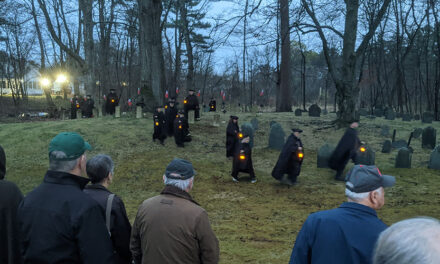Stephen Puleo discusses century-old North End tragedy
Published February 27, 2019
By DAN TOMASELLO
LYNNFIELD — The legacy of the Great Boston Molasses Flood continues to resonate 100 years later, author Stephen Puleo told a standing-room only crowd at the Meeting House on Feb. 20.
Puleo is the author of “Dark Tide: The Great Molasses Flood of 1919.” As the region and country mark the 100th anniversary of the North End tragedy that killed 21 people and injured 150 on Jan. 15, 1919, the Historical Society, Lynnfield Public Library and Friends of the Lynnfield Public Library came together to host the presentation at the Meeting House.
“The flood story captures the imagination of people not only in Boston and New England, but across the country,” said Puleo. “Twenty-one people were killed and 150 were injured during the tragedy. There was enormous property damage in the North End. The cleanup and the scenes in the hospital were surreal in many ways.”
Puleo said “Dark Tide” works on “two levels.”
“It’s a 10-year saga,” said Puleo. “It starts in the fall of 1915 with the construction of this huge tank on Commercial Street on the waterfront in Boston. And it ends in 1925 when the judge in the civil lawsuit that follows rules against United States Industrial Alcohol, a private company. It was a very important decision.”
Puleo said the large storage tank containing the molasses was poorly built.

AUTHOR Stephen Puleo gave a history lesson about the Great Boston Molasses Flood of 1919 to a standing-room only crowd at the Meeting House on Feb. 20. Puleo wrote a book about the disaster called “Dark Tide.” (Dan Tomasello Photo)
“It was rushed and built in shoddy fashion,” said Puleo. “It leaked from day one.”
Puleo noted the Molasses Flood is interconnected with a number of historical events. He said 90-95 percent of the molasses stored on Commercial Street was “distilled into industrial alcohol” during World War I.
“In normal peacetime, industrial alcohol was used for things like turpentine, paint thinners, dyes and those type of things,” said Puleo. “But in wartime, industrial alcohol was further processed and was used in the production of ammunition, nitroglycerin and TNT for the war effort. Most of the molasses stored in this tank was used during World War I. U.S. Industrial Alcohol’s major clients included large ammunition companies in the United States, and the British and French governments before the United States got into the war. When the U.S. got into the war in 1917, the United States government became a big client.”
Puleo recalled the anarchist movement in the U.S. was “very active” when the flood occurred. He noted U.S. Industrial Alcohol’s attorney attributed the disaster to an anarchist throwing a pipe bomb into the tank, but said there was no evidence to support the claim.
The author said a large number of Italian immigrants lived in the North End when the tragedy occurred, and many were not legal citizens.
“When this tank got plunked down in one of the busiest residential neighborhoods and commercial spots in all of Boston, there was barely a whimper from the neighborhood and the political hierarchy,” said Puleo. “It’s different today. Whenever anything gets built, neighbors turn out. None of that existed in 1919. This tank did not even require a building permit because it was considered a receptacle.”
After Colonel Hugh W. Ogden, a court appointed auditor, ruled in favor of the plaintiffs in 1925, Puleo said, “The entire relationship between government and business was altered.”
“It was called the Roaring Twenties for many reasons, but one of them was because the economy was doing pretty well,” said Puleo. “Not in the North End because it was a poor neighborhood, but it was a prosperous time. But at the same time, I think Americans were trying to strike a balance between trying to keep the good economy going with protecting employees and protecting the public. After the judge ruled against USIA in 1925, the stock market crash in 1929 and the early Franklin D. Roosevelt years in the 1930s, government imposed more laws and regulations on business. There is no doubt the Molasses Flood court case altered that relationship.”
An American tragedy
The flood occurred on Jan. 15, 1919 when the storage tank ruptured, sending a giant wave of molasses crashing through the North End. Puleo noted Boston Police Patrolman Frank McManus was undertaking “a routine beat walk around Commercial Street” just before the flood.
“Coincidently enough, he was making his routine call on the callbox on Commercial Street back to Boston Police headquarters when he heard what sounded like machine gun fire,” said Puleo. “He turned around and saw this molasses tank disintegrate before his eyes. McManus had the presence of mind to make one of the most unbelievable calls back to Boston Police headquarters, and said ‘send all available rescue personnel immediately, there is a wave of molasses coming down Commercial Street.’ I can guarantee you they haven’t had a call like that since.”
Puleo said the molasses wave traveled 35 miles per hour, was 35-feet high and was 160-feet wide.
“Think of this as a mini tidal wave,” said Puleo. “It destroyed everything in its path.”
Puleo said the molasses started to harden the day after the flood. He said the city pumped millions of gallons of salt water from Boston Harbor and “washed the vast majority of the molasses into Boston Harbor.”
“The area was cleaned up in about six months,” said Puleo.
Puleo shared stories about the people who were there. He noted firefighter George Layhe was stationed at a firehouse located 80 feet from the tank when the flood occurred.
“When the wave slammed into the firehouse, there were firefighters who got trapped in an 18-inch crawl space,” said Puleo. “There was four or five underneath there trying to hold their heads above molasses. George Layhe was under there for four hours before he finally succumbed.”
Puleo noted two 10-year-old children, Pasquale Iantosca and Maria Di Stasio, were killed during the flood.
“They were home from school at lunchtime, which is when the disaster took place,” said Puleo. “They were collecting firewood around the tank site. Normally, they were down there scooping up pails of molasses that had leaked from the sides. Maria’s body was found that afternoon. Pasquale’s body was not found until a week later. They were only able to identify his body because his mother dressed him in two sweaters that day.”
Puleo said USIA Assistant Treasurer Arthur P. Jell was a “villain” in the case.
“(Jell) was put in charge of this tank project,” said Puleo. “He was in charge of the construction and overseeing it once it was in production. The only problem was he had no architectural experience, no engineering experience and no technical experience at all. He didn’t know how to read plans or blueprints, and knew nothing about safety. When the steel was delivered for the tank, it was thinner than what the specifications called for. There were no real inspections or clerk of the works. The work was done fast, but it was not done well. There was even a worker who died while the tank was being constructed.”
After an employee told Jell the tank was leaking molasses, Puleo said Jell told the employee “to keep his mouth shut.” He also said Jell had “the tank painted from a steel blue color to a brownish red color.”
“It was the color of molasses to camouflage the stuff coming down the side,” said Puleo. “(Jell) was supposed to test the tank by filling it with water. He testified in court that he tested this 50-foot tank with 6-inches of water.”
Puleo said one of the heroes in “Dark Tide” was USIA employee Isaac Gonzalez.
“(Gonzalez) worked at the plant site and was a jack of all trades,” said Puleo. “He warned Jell about the leaks. Isaac had premonitions that this tank was going to collapse. In the summer of 1918, Isaac Gonzalez ran from his apartment in the South End of Boston to the tank site in the North End at 2:30 or 3 a.m. He ran to the back of the tank, opened the valve and let some of the molasses out into Boston Harbor. He ran back home after closing the valve. He testified in court that it was his way of staving off this disaster. He was the conscience of U.S. Industrial Alcohol. He was so anxious and stressed that he quit his job in September 1918, four months before the flood.”
Puleo said the story’s main hero was Colonel Hugh W. Ogden, a former military officer who was appointed as the case’s auditor.
“Ogden was asked to hear this case,” said Puleo. “It was a civil case. No criminal charges were brought. There was a grand jury who sat on the Great Boston Molasses Flood, but no indictments were returned, probably because no criminal laws were broken. But he was asked by the Superior Court to sit on this case. The court suggested it would take six weeks of his time. It took three years. There were 1,000 witnesses, 1,500 exhibits and 25,000 pages of testimony. It was the first case to use expert witnesses on each side. It was an enormous class action suit and is still the largest in Massachusetts history.”
Puleo said, “Ogden went out of his way to be fair to the plaintiffs in this case,” most of whom he said were Irish or Italian laborers. After the attorneys on both sides rejected Ogden’s request to have the laborers testify on Saturday afternoons, he allowed laborers to testify up until 10 p.m.
“There were many sessions of this court case that were in session until 10 o’clock at night,” said Puleo.
Puleo said the plaintiffs were awarded $628,000 in damages. While Puleo said the flood was devastating, he said it led to positive changes.
“What the Great Boston Molasses Flood did for building construction standards is what the Cocoanut Grove Fire did two decades later for fire standards,” said Puleo. “These Boston disasters had positive long-term ramifications for the entire country.”




